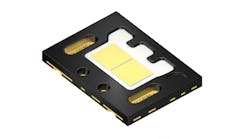With the return of former Osram executive Aldo Kamper to the ams Osram fold, LEDs are back in the thick of the action at the combined company.
Not that they had gone away under former boss Alexander Everke, who ceded the top job to Kamper on April 1.
But in the space of five weeks from June through late July, the Premstaetten, Austria company announced no fewer than four new LED chips, with perhaps the most notable being its pixelated Eviyos 2.0 micro LED for intelligent automotive headlights.
It was a flurry that might have been less likely under Everke. Under his stewardship, ams Osram had continued to expand its stable of sensors and other non-emitters, with LEDs seemingly taking a back seat.
No more. Soon after arriving, Kamper hinted that the ams side of the company’s portfolio could be in for significant pruning.
He delivered on that possibility ten days ago, as ams Osram said during its second-quarter results announcement that it will withdraw from a chunk of the ams side of the business.
“The company is refocusing its semiconductor portfolio on its profitable core in differentiated, intelligent sensor, and emitter components,” ams Osram said. “The non-core and lower performing portfolio with revenues of around €300 to €400 million — including amongst others, passive optical components — will be exited.”
Passive optical components are believed to include many of the products that ams Osram has sold to smartphone makers, a group of customers that have long contributed significantly to the company’s revenues over the years.
The measures are part of a restructuring aimed a reversing financial difficulties, which, in the second quarter, included a write-down of €1.3 billion and an unadjusted loss of the same size. They come following considerable globe trotting by Kamper as he contemplated how to regroup the company. Longer-term financial challenges remain.
The reorganization includes paring down the the semiconductor group from what was three divisions into two. Effective Jan. 1, those two will be emitters (LEDs and lasers) and “analog mixed signal ICs.” Until then, the three semiconductor divisions will continue to be Opto Semiconductors, Advanced Optical Sensing, and Image Sensing Solutions.
On a second-quarter results call, Kamper told analysts that the new approach to the semiconductor business will increase the instances in which ams Osram combines different chips into one package for a customer. The Eviyos 2.0 pixelated micro LED is one such example, he said.
“Combining our own ICs with an emitter or sensor in a differentiated package and writing our own firmware can provide a much higher customer value,” Kamper told analysts. “An example is our recently announced cutting-edge, 25,000-pixel automotive forward lighting Eviyos solution where we use our own highly sophisticated driver, IC, and ASIC.”
Eviyos has been under development since around 2017 (follow the links in that story for further history). LEDs Magazine has long suspected it would be a micro LED; with its July 19 announcement of Eviyos’ market availability, the company indeed confirmed the micro LED aspect.
Eviyos 2.0 is an array of 25,600 individually controllable micro LEDs, each acting as a pixel. Combined with a camera in high-beam mode, Eviyos can switch off enough pixels to avoid glare for oncoming motorists, thus enabling the uninterrupted use of high-beam mode. It is also designed to project along curves, giving extended visibility. Ams Osram is also hailing it as a technology that can project messages onto the roadway to warn other drivers of hazards and road conditions.
Kamper said the company has received “tremendous traction” for the product, including a commitment from Italian automotive supplier Marelli.
In another recent LED announcement, ams Osram in late July unveiled a product that intelligently adjusts colors and brightness in automotive interiors. It is packaging the interactive RGB chip with an integrated circuit “that features three LED drivers, a serial bus interface supporting the (protocol), a temperature sensor, and on-chip memory.” The chip is called the Osire E3731i.
Also this summer, ams Osram introduced two new horticultural LED chips.
It’s no coincidence that the reinvigoration of the LED side of the business comes following Kamper’s arrival. Kamper had led Osram’s Opto Semiconductor division, but left the firm in August 2019 prior to ams’ acquisition of Osram, which the E.U. cleared in July 2020.
While at Osram, Kamper played a big role in the 2017 opening of the Kulim, Malaysia factory that is shaping up to be critical to the company’s future in micro LEDs when it starts production using 8-inch rather than 6-inch wafers. Ams Osram’s future relies heavily on the micro LED business, and the company is counting on significant revenues from the Kulim micro LEDs starting in 2025.
Further re-emphasizing the importance of LEDs to ams Osram, Kamper reminded analysts on the results call that in 2022 the company was the world’s second-largest LED supplier after Nichia, according to one third-party report.
And in another reminder of the role that the former Osram plays in the ams Osram orbit, he pointed out that the company’s Lamps & Systems group (L&S) is the world’s leading supplier of aftermarket headlamps, according to the company’s own research. L&S sells LED, halogen, and xenon lamps.
MARK HALPER is a contributing editor for LEDs Magazine, and an energy, technology, and business journalist ([email protected]).
Follow our LinkedIn page for our latest news updates, contributed articles, and commentary, and our Facebook page for events announcements and more. You can also find us on Twitter.

Mark Halper | Contributing Editor, LEDs Magazine, and Business/Energy/Technology Journalist
Mark Halper is a freelance business, technology, and science journalist who covers everything from media moguls to subatomic particles. Halper has written from locations around the world for TIME Magazine, Fortune, Forbes, the New York Times, the Financial Times, the Guardian, CBS, Wired, and many others. A US citizen living in Britain, he cut his journalism teeth cutting and pasting copy for an English-language daily newspaper in Mexico City. Halper has a BA in history from Cornell University.









